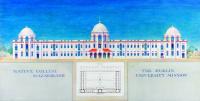Nabobs, soldiers and imperial service: the Irish in India
Published in
18th–19th - Century History,
20th-century / Contemporary History,
Issue 4 (July/August 2010),
News,
Volume 18

Front elevation and plan of Dublin University Mission’s projected ‘Native College’ at Hazaribagh, Bengal, reproduced on a banner hanging from the ceiling in the ‘Irish in India’ exhibition in the Long Room, Trinity College Library, until 3 October 2010. (Trinity College, Dublin)
Most of the Irish who were in India in the early phases of the British occupation went there in the military or civilian service of the London-based East India Company. Missionaries and planters followed in the nineteenth century. India was a place where vast fortunes could be made. Successful Irishmen included James Alexander and Robert Gregory. Alexander bought the estate of Caledon, Co. Tyrone, sat in the Irish House of Commons and then progressed through the peerage to finish as earl of Caledon. Robert Gregory, Co. Galway, made himself rich by the age of 40 and returned to London, where he became a director of the East India Company. Besides investing in land in Essex and Cheshire, he bought the estate of Coole, Co. Galway. While some made fortunes, many succumbed to the climate and died young.
Until 1855 recruitment to the Company’s service was by nomination of a director; many were known to sell nominations. The unscrupulous trading and machinations of Company employees in the 1760s and early 1770s was curbed by the first of a series of British acts of parliament passed in 1773. Successive renewals of the Company’s charter in 1793, 1813 and 1833 prised open the territory to traders and missionaries. Several of the government-appointed governors-general, including the Irish-born Marquess Wellesley, pursued the route of conquest, and by the late 1850s the Company controlled most of modern-day Pakistan, India and Bangladesh. The Sepoy mutiny in 1857, which was not completely crushed until 1859, was the death-knell of the Company, for the British government took over its powers and territory in 1858. Several Irishmen were prominent in putting down the mutiny, including Henry and John Lawrence, both educated at Foyle College in Derry, and John Nicholson, a Dublin-born soldier who led troops in the assault on Delhi. The mutiny was reflected in Ireland in several popular ballads, two of which display contrasting sympathies, one being anti-British, and the other calling for revenge for the massacre of Europeans.
Just before control of India passed from the Company, recruitment to its service had been changed from nomination to competitive examination. This opened the way for able graduates to find a promising career. The Irish universities supplied men to the Indian civil service for over 80 years and a number of works by them are included in the exhibition. Scholarly work was produced by Sir George Abraham Grierson with the magisterial Linguistic survey of India, produced between 1898 and 1928, and by Whitley Stokes, who compiled the consolidated Anglo-Indian Codes of procedure in civil and criminal law. The Indian civil service achieved a high reputation for impartiality, competence and incorruptibility. The universities also supplied engineers who worked on large public schemes for water management and on railway lines. By the early 1860s about 30% of the engineers educated at Trinity College Dublin had gone to India.
The exhibition also features the lighter side of life in India, with illustrations of tiger-shooting and pig-sticking. According to Robert Baden-Powell, who later founded the scouting movement, pig-sticking was ‘a sport second to none and invaluable to our prestige and supremacy in India’. The work of missionaries became a more prominent feature of the Irish presence after 1840, with Roman Catholic priests and nuns setting up schools in Madras and other cities. Anglican graduates of Trinity College established the Dublin University Mission to Chota Nagpur at the end of the nineteenth century.
As the Irish presence waned, especially after 1921, when many Irish regiments in the British Army were disbanded, the Indian nationalist movement drew inspiration from the Irish example. Speeches by Éamon de Valera and Seán T. O’Kelly in support of Indian independence are featured. The Irish–Indian relationship has changed completely over the past half-century as Indian influences have become prominent features of Irish life. HI
Charles Benson is Keeper of Early Printed Books and Special Collections in the Library of Trinity College, Dublin.

















